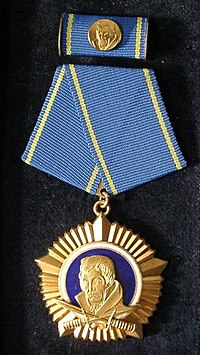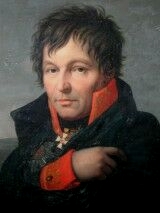Scharnhorst Order
| Scharnhorst Order (highest military award in the GDR) |
|
|---|---|

|
|
| Medal on ribbon (obverse) | |
| Founder: | Council of Ministers of the GDR |
| Foundation year: | 1966 |
| Strap buckle: | |
| Carrying method: | left breast side |
The Scharnhorst Order was an order of the GDR that could be awarded for services to strengthen the GDR militarily or otherwise. It was donated on February 17, 1966 by the GDR Council of Ministers and awarded until the GDR was dissolved in 1990.
Draft of the order
The Scharnhorst Order was originally designed by Klaus Bernsdorf . The sculptural representation of the order itself was then carried out by the Berlin sculptor Fritz Schulz .
Award terms
The Scharnhorst Order was a one-class order and was named after the Prussian General Gerhard von Scharnhorst . Scharnhorst was perceived in the GDR as a progressive military theorist who campaigned for reforms in the Prussian military system and laid the foundations for a people's army . The NVA saw itself directly in the tradition of the German wars of freedom from 1813 to 1815 as well as in fulfilling the NVA as a “people's army”.
The medal was awarded for outstanding:
- military merit
- Services to the protection of the GDR as well
- Strengthening the national defense of the GDR
to relatives, units, associations and other institutions (including civil institutions):
- of the National People's Army (NVA) on the anniversary of the NVA on March 1st of each year
- of the border troops of the GDR (GT) on the anniversary of the GT on December 1st of each year
- of the civil defense of the GDR (ZV) on the anniversary of the ZV on February 11th
- of the Ministry for State Security (MfS) on the anniversary of the MfS on February 8 of each year.
In addition, it was planned to award the order to members of other armed organs of the GDR, which, however, did not necessarily have to be part of an armed organization. Awards were also provided to foreign military personnel and have been practiced. For example to Marshal Viktor Georgievich Kulikov . The medal was always presented on the day of its award with an elaborately crafted certificate. There was also a one-time grant of 5000 marks .
Carrying method
The Scharnhorst Order was worn on the left side of the chest on a pentagonal ribbon clasp (based on the Russian model). When awarded several times, the order was worn according to the number of awards it received.
Appearance and material
Since it was first introduced in 1966 to 1989, the medal was subject to multiple changes, whereby the basic appearance of the medal was only slightly changed. The Scharnhorst Order consisted of a five-armed star underlaid with golden rays. In the center medallion of the star there was a golden portrait of Scharnhorst in a blue field with a white frame, under which two crossed golden daggers were placed.
Executions
- 1. Execution 1966–1972: Production of the order from gold-plated 900 silver, 5 rivets on the back.
- 2. Execution 1973–1980: Production of the medal from gilded non-ferrous metal , the back held smooth with a centrally located rivet.
- 3. Execution 1980–1989: introduction of a patterned (pebbled) smooth back without rivets, medallion only glued on.
The short execution of the production shows that the Scharnhorst Order has lost more and more of its quality in its 23 years of existence, initially the elimination of precious metals up to the gluing of individual elements.
Ribbon color
The ribbon of the Scharnhorst Order was blue with golden percussion (stripes of the same color on both sides). The same play of colors is reflected on the ribbon clasp, on the center of which a miniature of Scharnhorst's medallion was placed.
measurements and weight
Exact measurements are only possible to a limited extent due to the different manufacturing processes with regard to the use of materials. The size information is therefore based on mean values. These goods:
- Height including eyelet: 45.45 mm to 46.37 mm
- Width: approx. 42.5 mm
- Total width of the daggers: approx. 30.2 mm
- Weight: 44 g to 44.5 g
Known porters
- Klaus-Dieter Baumgarten
- Friedrich Dickel
- Leopold Gotthilf
- Heinz Hoffmann
- Wojciech Jaruzelski
- Heinz Keßler
- Viktor Georgievich Kulikov
- Peter Koch
- Erich Mielke
- Erich Peter
- Werner Prosetzky
- Willi Stoph
- Fritz Streletz
- Karl-Heinz Wagner
- Erich Dirwelis
- Theodor Hoffmann
Others
The Scharnhorst Order, like many other orders from the GDR (e.g. Karl Marx Order ), was awarded to entire units, associations or companies in the form of a flag ribbon.
literature
- Frank Bartel, Awards of the German Democratic Republic , Berlin 1979
- Awards of the National People's Army. Berlin 1994
- Orders and medals - awards of the GDR. Leipzig 1983
- The "Scharnhorst Order". Militaria magazine No. 46 1992
- Militaria magazine No. 114 October 2004
